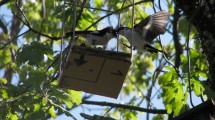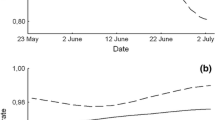Abstract
We examined the changes in the intensity of intra-specific aggression (ISA) in a kestrel (Falco tinnunculus canariensis) population throughout the breeding season, in order to evaluate the main hypotheses regarding ISA (defence of parentage, food, nest-site and offspring). Each pair was presented with a live caged adult male or female as a conspecific intruder. The intensity of ISA did not vary significantly during the breeding season, and nor did it correlate with offspring value, or food availability. Our island-dwelling kestrel population showed low fluctuation in ISA during the breeding season, and similar levels of aggression in both members of the pair towards male or female intruders. These findings support the nest-site defence hypothesis. Pairs with more exposed nest-sites showed increased ISA, unexplained by offspring value. We suggest that this behaviour is related with nest-site conspicuousness and vulnerability. The pairs displaying greater ISA also showed greater aggression towards humans, the main local predator. This may indicate that defensive behaviour evolved in the past when it was advantageous against predators, and became a trait. Compared with the non-island reference population, we only found differences in ISA during the pre-laying phase: lower intensity of aggressive behaviour between males, and higher between females.

Similar content being viewed by others
References
Aparicio JM (1994) The effect of variation in the laying interval on proximate determination of clutch size in the European Kestrel. J Avian Biol 25:275–280
Ausden M (1996) Invertebrates. In: Sutherland WJ (ed) Ecological census techniques: a handbook. Cambridge University Press, Cambridge, pp 139–177
Birkhead TR, Møller AP (1992) Sperm competition in birds. Evolutionary causes and consequences. Academic, London
Blondel J (2000) Evolution and ecology of birds on islands: trends and prospects. Vie Milieu 50:205–220
Blondel J, Chesel D, Frochot B (1988) Bird species impoverishment, niche expansion, and density inflation in Mediterranean island habitats. Ecology 69:1899–1917
Brown JL (1964) The evolution of diversity in avian territorial systems. Wilson Bull 76:160–169
Burnham KK, Burnham WA, Newton I (2009) Gyrfalcon Falco rusticolus post-glacial colonization and extreme long-term use of nest-sites in Greenland. Ibis 151:514–522
Carrascal LM, Palomino D (2005) Preferencias de hábitat, densidad y diversidad de las comunidades de aves de Tenerife (Islas Canarias). Anim Biodivers Conserv 28(2):101–119
Carrillo J, Aparicio JM (2001) Nest defence behaviour of the Eurasian Kestrel Falco tinnunculus against human predators. Ethology 107:865–875
Carrillo J, González-Dávila E (2005) Breeding biology and nests characteristics of the Eurasian Kestrel Falco tinnunculus in different environments on an Atlantic island. Ornis Fenn 82(2):55–62
Carrillo J, González-Dávila E (2010) Impact of weather on breeding success of the Eurasian Kestrel Falco tinnunculus in a semi-arid island habitat. Ardea 98:51–58
Carrillo J, Hernández EC, García R, Nogales M, Delgado G, Ramos T (1994) Geographic variations in the spring diet of Falco tinnunculus L. in Fuerteventura and El Hierro (Canary Islands). Bonn Zool Beitr 45:39–48
García JT, Arroyo BE (2002) Intra- and interspecific agonistic behaviour in sympatric harriers during the breeding season. Anim Behav 64:77–84
Gowaty PH (1981) Aggression of breeding eastern bluebirds (Sialia sialis) toward their mates and models of intra- and interspecific intruders. Anim Behav 29:1013–1027
Hakkarainen H, Korpimäki E (1996) Competitive and predatory interactions among raptors: an observational and experimental study. Ecology 77:1134–1142
Huntingford FA (1976) The relationship between inter- and intra-specific aggression. Anim Behav 24:485–497
Jamieson IG, Seymour NR (1983) Inter- and intra-specific agonistic behavior of Ospreys (Pandion haliaetus) near their nest sites. Can J Zool 61:2199–2202
MacLean SF Jr, Seastedt TR (1979) Avian territoriality: sufficient resources or interference competition. Am Nat 114:308–312
Margalida A, Bertran J (2005) Territorial defence and agonistic behaviour of breeding bearded vultures Gypaetus barbatus toward conspecifics and heterospecifics. Ethol Ecol Evol 17:51–64
Martin TE (1986) Competition in breeding birds. On the importance of considering processes at the level of the individual. Curr Ornithol 4:181–210
Martindale S (1982) Nest defense and central place foraging: a model and experiment. Behav Ecol Sociobiol 10:85–89
Marzol MV (1988) La lluvia: un recurso natural para Canarias. Servicio de publicaciones de la Caja General de Ahorros de Canarias 130, Editorial Confederación Cajas de Ahorros, Santa Cruz de Tenerife
Masman D, Dijkstra C, Daan S, Bult A (1989) Energetic limitation of avian parental effort: field experiments in the Kestrel (Falco tinnunculus). J Evol Biol 2:435–455
Massemin S, Korpimäki E, Wiehn J (2000) Reversed sexual size dimorphism in raptors: evaluation of the hypotheses in kestrels breeding in a temporally changing environment. Oecologia 124:26–32
Molina M (1985) Spatial and temporal behaviour of Gallotia galloti in a natural population of Tenerife. Bonn Zool Beitr 36:541–552
Neudorf DLH (2004) Extrapair paternity in birds: understanding variation among species. Auk 121:302–307
Newton I (1979) Population ecology of raptors. Poyser, Berkhamsted
Newton I (1998) Population limitation in birds. Academic Press, London
Newton I, Wyllie I (1992) Fidelity of nesting territory among European sparrowhawks in three areas. J Raptor Res 26:108–114
Palokangas P, Alatalo RV, Korpimäki E (1992) Female choice in the kestrel under different availability of mating options. Anim Behav 43:659–665
Ratcliffe D (1980) The peregrine falcon. Poyser, Calton
Robinson-Wolrath SI, Owens IPF (2003) Large size in an island-dwelling bird: intraspecific competition and the dominance hypothesis. J Evol Biol 16:1106–1114
Stamps JA, Buechner M (1985) The territorial defense hypothesis and the ecology of insular vertebrates. Q Rev Biol 60:155–181
Tellería JL (1986) Manual para el censo de los vertebrados terrestres. Ed. Raíces, Madrid
Thorstrom R, Morales CM, Ramos JD (2001) Fidelity to territory, nest site and mate, survivorship and reproduction of two sympatric forest falcons. J Raptor Res 35:98–106
Tolonen P, Korpimäki E (1994) Determinants of parental effort: a behavioural study in the Eurasian Kestrel, Falco tinnunculus. Behav Ecol Sociobiol 35:355–362
Tulley JJ, Huntingford FA (1988) Additional information on the relationship between intra-specific and anti-predator behaviour in the Three-Spined Stickelback, Gasterosteus aculeatus. Ethology 78:219–222
Vergara P, Fargallo JA (2007) Delayed plumage maturation in Eurasian Kestrels: female mimicry, subordination signalling or both? Anim Behav 74:1505–1513
Vergara P, Aguirre JI, Fargallo JA, Dávila JA (2006) Nest-site fidelity and breeding success in White Stork Ciconia ciconia. Ibis 148:672–677
Vergara P, de Neve L, Fargallo JA (2007) Agonistic behaviour prior to laying predicts clutch size in Eurasian kestrels: an experiment with natural decoy. Anim Behav 74:1515–1523
Vergara P, Martínez-Padilla J, Fargallo JA (2012) Differential maturation in sexual traits: revealing sex while reducing male and female aggressiveness. Behav Ecol. doi:10.1093/beheco/ars159
Village A (1982) The home range and density of kestrels in relation to vole abundance. J Anim Ecol 51:413–428
Village A (1983) The role of nest-site availability and territorial behaviour in limiting the breeding density of kestrels. J Anim Ecol 52:635–645
Village A (1990) The kestrel. Poyser, London
Wallace RA (1978) Social behavior on islands. In: Bateson PPG, Klopfer PH (eds) Perspectives in Ethology. Plenum, New York, pp 167–204
Wallin K (1987) Defence as parental care in Tawny Owls (Strix aluco). Behaviour 102:213–230
Warkentin IG, James PC, Oliphant LW (1991) Influence of site fidelity on mate switching in urban-breeding merlins (Falco columbarius). Auk 108:294–302
Whittaker RJ (1998) Island biogeography. Ecology, evolution and conservation. Oxford University Press, Oxford
Whittaker RJ, Fernández-Palacios JM (2007) Island biogeography. Ecology, evolution and conservation. Oxford University Press, Oxford
Wiklund CG, Village A (1992) Sexual and seasonal variation in territorial behaviour of kestrels, Falco tinnunculus. Anim Behav 43:823–830
Acknowledgments
We are indebted to José Miguel Aparicio for encouragement throughout the project. We thank Fini, Jorge and Cristina—the family of one of us (J.C.)—Nicolás Trujillo, José Pedro Martín, and Carlos Izquierdo for their help in the field. The people of the area let us have access to their lands. Plácido Marrero showed us the location of some nest-sites. The Canary Government gave us permission to study and ring a protected species and lent us two permanently disabled kestrels, male and female, from the Fauna Rehabilitation Centre in Tenerife. Michael Lee McLean helped with the English version of the manuscript. José Miguel Aparicio, Juan Antonio Fargallo, Michael Lee McLean, and Pablo Vergara offered valuable comments on an earlier version of the manuscript. The fieldwork was performed during J.C.’s affiliation with the Department of Animal Biology (Zoology) of La Laguna University. E.G.D.’s research was partially supported by a Spanish Ministry of Science Project (MTM 2010-16828). The suggestions from the editor and two anonymous reviewers improved the manuscript.
Author information
Authors and Affiliations
Corresponding author
About this article
Cite this article
Carrillo, J., González-Dávila, E. Aggressive behaviour and nest-site defence during the breeding season in an island kestrel population. J Ethol 31, 211–218 (2013). https://doi.org/10.1007/s10164-013-0369-x
Received:
Accepted:
Published:
Issue Date:
DOI: https://doi.org/10.1007/s10164-013-0369-x




